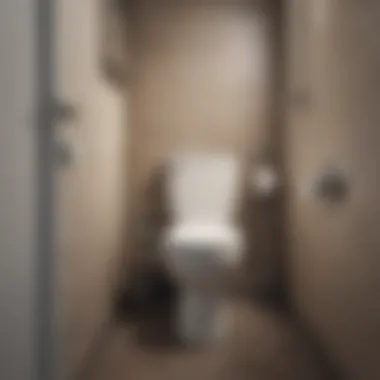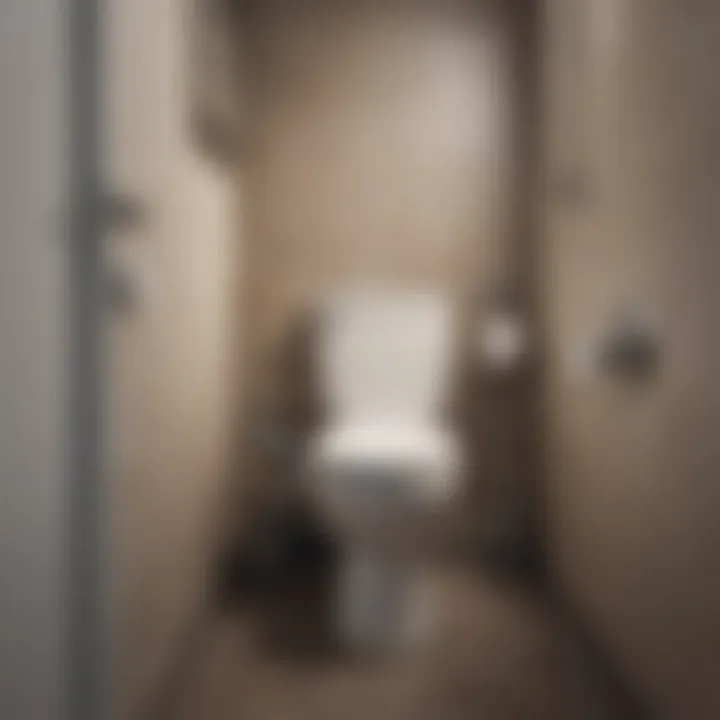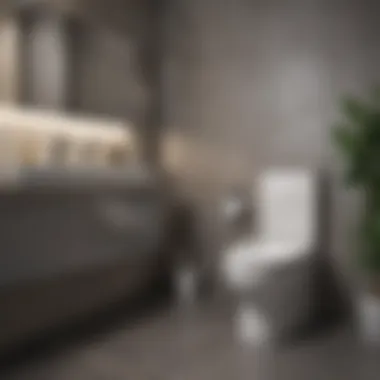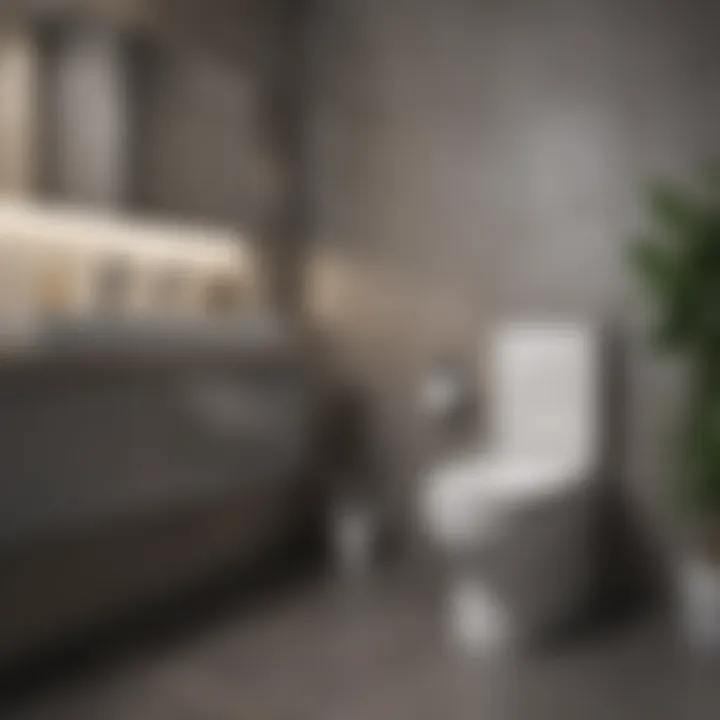Strategies for Effective Resolution of Toilet Blockages


Intro
Toilet blockages represent a common issue faced by many homeowners and property managers. They disrupt daily life and can cause significant inconvenience. Understanding the root causes and employing effective strategies to address such blockages is crucial. This article seeks to elucidate various methods for tackling toilet clogs effectively while highlighting prevention techniques.
Understanding Toilet Blockages
To grasp effective resolution strategies, one must first understand what leads to toilet blockages. Common causes include excessive toilet paper, large objects being flushed, or a buildup of waste. In older plumbing systems, tree roots can also infiltrate pipes, leading to more severe blockages.
Common Symptoms
- Slow drainage: A noticeable sign that can indicate a blockage.
- Gurgling noises: Sounds emanating from the toilet bowl or pipes may suggest trapped air.
- Overflow: The toilet may overflow when flushed, indicating a severe blockage.
Prevention Techniques
Proactive measures can significantly reduce the risk of toilet blockages.
Regular Maintenance
- Flushing habits: Only flush waste and toilet paper. Avoid flushing items like wipes and feminine products.
- Routine checks: Inspect plumbing regularly for leaks or signs of wear.
Educating Family Members
Informing everyone in the household about proper flushing etiquette can ward off many common issues. Discuss what items are appropriate to flush and which ones are not.
Strategies for Clearing Blockages
When faced with a blockage, various techniques can be employed to clear it effectively. Understanding the tools and methods available is crucial.
Plunger Technique
A standard tool in every household, the plunger can be effective for minor blockages. Use a flanged plunger designed for toilets. Ensure a secure seal and apply firm pressure.
Toilet Auger
For more stubborn clogs, a toilet auger is helpful. It consists of a long cable that can reach deeper into the pipes to dislodge blockages. Insert the auger gently and twist the handle to navigate the obstruction.
Chemical Solutions
In some cases, using a chemical drain cleaner can assist in clearing a blockage. Select a product suitable for toilets and follow the manufacturer's instructions. However, always approach chemicals with caution, as they can be harmful to plumbing fixtures if misused.
Regular maintenance and proper use of the toilet can prevent most blockage issues.
Ending
Effectively resolving toilet blockages involves understanding their causes, employing preventative measures, and utilizing appropriate tools for clearing. Homeowners and property managers can benefit from a systematic approach to maintain optimal toilet function, ensuring minimal disruption to daily life. In this ongoing pursuit of knowledge, staying informed about the latest methods for toilet maintenance can foster a better living environment.
Foreword
Toilet blockages are not just an inconvenience; they can disrupt the daily functioning of a household or any space that relies on modern plumbing. Understanding the resolution strategies for these blockages is crucial for maintaining a functional and sanitary environment. This article delves into various dimensions of toilet blockages, providing insights on their causes, symptoms, and effective solution techniques.
The significance of addressing toilet blockages goes beyond mere convenience. They can lead to significant water damage, unpleasant odors, and expensive repairs if neglected. Homeowners and property managers alike should equip themselves with knowledge on prevention and resolution. By examining practical strategies, effective tools, and best practices, readers can minimize the risk of future occurrences.
Moreover, understanding the mechanics behind blockages fosters a more proactive approach. Being able to identify early warning signs such as slow drainage or unusual noises can expedite intervention, eliminating the chances of severe damage. It's essential to establish proper maintenance routines and educate all members of a household regarding what is considered flushable. In a world where a small amount of knowledge can save considerable costs and stress, it's worthwhile to navigate these strategies.
In summary, this article aims to systematically guide readers through the complexities of toilet blockages. By providing well-researched information, practical solutions, and preventive measures, it sets out to empower its audience, ensuring that they are prepared to tackle any complications effectively.
Understanding Toilet Blockages
Understanding toilet blockages is crucial as it serves as a foundation for effectively resolving the issues that arise when toilets become non-functional. Knowing the nature of a blockage helps one take precise actions, thereby minimizing potential damage to the plumbing system. This section emphasizes the importance of early identification and appropriate responses to blockages. By understanding how different types of blockages form and their causes, homeowners and property managers can implement more effective strategies for prevention and resolution.
What is a Toilet Blockage?
A toilet blockage occurs when waste and water cannot flow freely through the toilet and drainage system. This blockage can lead to a buildup of water, causing overflow or complete failure of toilet function. The importance of defining a toilet blockage lies in recognizing the severity and urgency of the issue. Awareness of how and when a blockage occurs allows individuals to address it swiftly and avoid further complications in the plumbing system.


Common Causes of Blockages
To effectively manage toilet blockages, it is useful to know their common causes. Below are detailed explanations of several prevalent causes:
Excessive Toilet Paper Use
Excessive toilet paper use is one primary cause of blockages. Using too much toilet paper can easily overwhelm the toilet’s flushing capability. Toilets are designed to handle a specific amount of waste and toilet paper at any time. When this limit is exceeded, it can result in clogs. Recognizing this can guide users to be more conservative with paper use, thereby reducing the risk of future blockages.
Foreign Objects
Foreign objects can significantly contribute to toilet blockages. Items such as toys, sanitary products, or other non-flushable materials can obstruct the flow of waste. The key characteristic of this type of blockage is its unpredictability. Unlike excessive toilet paper use, foreign objects can be introduced into the toilet unintentionally. Therefore, awareness of what should not be flushed is vital for maintaining optimal toilet function.
Flushing Non-Flushables
Flushing non-flushables is another prevalent cause of blockages. Many individuals might believe certain items, like wipes or paper towels, are safe to flush. This misunderstanding can lead to unexpected clogs. The unique feature of flushing non-flushables is that they often do not break down in water like toilet paper. This characteristic makes it essential for individuals to educate themselves on acceptable flushing practices to avoid problems.
Routine Maintenance Failures
Routine maintenance failures also pose a risk for blockages. Neglecting regular checks or servicing can degrade the efficiency of plumbing systems. Accumulation of debris over time can lead to significant problems. A key aspect here is the recognition that regular maintenance is preventive. Taking time to perform basic checks or call in a maintenance professional can drastically reduce the likelihood of facing severe blockages.
Signs of a Blocked Toilet
Recognizing the signs of a blocked toilet is critical for maintaining a functional and sanitary bathroom environment. Ignoring these signs can lead to more severe issues which may require professional intervention. Clear indicators can help prevent small blockages from escalating into full-blown plumbing disasters.
Identifying Early Warning Signs
Evaluating the behavior of your toilet can provide vital hints regarding its condition. Common characteristics can signal pending blockages. Addressing these symptoms promptly can save time, money, and stress.
Slow Drainage
Slow drainage is one of the primary indicators of a blockage. This issue arises when water does not flow smoothly through the pipes, often taking much longer to empty than expected. A key characteristic of slow drainage is the water level rising slowly after a flush. This is a common choice in discussions about early signs of a blockage. The advantage of identifying slow drainage early is it allows homeowners to address the problem before it worsens. However, its disadvantage may be that it could be dismissed as a minor issue before further investigation takes place.
Unusual Noises
Unusual noises during toilet operation often indicate a blockage. From gurgles to bubbling, such sounds can disrupt the routine of using the bathroom. A key characteristic of unusual noises is that they may be heard during flushing or while water is draining. This symptom is beneficial because it alerts the user to check on the toilet's condition before issues escalate. Unique to this sign, these noises can also indicate air trapped in the plumbing, which may lead to further complications if ignored.
Water Level Fluctuations
Water level fluctuations can occur in both the bowl and tank. A key characteristic of this issue is unpredictable changes in water height, which may lead the user to question the functionality of the toilet. Recognizing this can be a beneficial habit as it prompts users to evaluate flushing effectiveness. While water level fluctuations can be a clear warning, a disadvantage is that not all users may pay attention to subtle changes, dismissing them as normal behavior.
When to Act
Acting swiftly upon noticing signs of blockage can prevent more complex issues from developing. If slow drainage or unusual noises persist, it is advisable to take action as soon as possible. When water levels fluctuate, it may be necessary to investigate further before normal use resumes.
A proactive approach ensures that the problem is addressed before it affects daily routines or damages plumbing systems. Deciding to act involves assessing the symptoms and determining if immediate intervention, such as plunging or calling a plumber, is warranted. Regularly monitoring toilet function not only enhances convenience but also prevents costly repairs.
Initial Response to Blockage
Handling a toilet blockage promptly and effectively is critical. A timely response can prevent further problems, including damage to plumbing systems or unpleasant sanitary situations. Understanding how to assess the situation allows for a more strategic approach to resolving the issue. This phase is not just about reacting; it's about assessing the seriousness of the blockage and deciding the best immediate action. Taking the right steps early can save time and money.
Assessing the Situation
The first step in addressing a toilet blockage is to assess the situation thoroughly. One should observe the toilet's current condition. Is the water rising unusually high after a flush? Is it draining slowly? The answers to these questions can indicate the severity of the blockage. If there is a risk of overflow, it may necessitate an immediate response.
It's also essential to note any unusual noises coming from the toilet. Gurgling or bubbling sounds could indicate deeper plumbing issues that might need addressing. By understanding these early signs, one can make a more informed decision on the appropriate steps to take next.
Gathering Necessary Tools
Before attempting to clear a blockage, gathering the right tools is crucial. Having the necessary equipment can make the process smoother and more effective. Here are some common tools you might find useful:
Plungers
Plungers are one of the most basic yet effective tools for addressing toilet blockages. They work by creating a vacuum that can dislodge stuck debris in the pipes. A key characteristic of a plunger is its rubber cup that seals around the toilet drain, allowing strong pressure changes. Plungers are popular due to their simplicity and low cost, making them a first choice for homeowners.
A unique feature of plungers is the different styles available, such as the flange plunger specifically designed for toilets. This type helps create a better seal and enhances efficiency against clogs compared to standard plungers. However, they require a bit of technique for optimal use, as improper handling might not yield results.


Augers
Augers serve a specific purpose in clearing blockages deeper in the plumbing system. They consist of a long, flexible cable with a spiral end that can grab or break up clogs. A significant characteristic of augers is their ability to reach far into the drain, where plungers cannot. They are effective for tougher blockages that are not responding to plunging.
The unique feature of an auger is its rotating action, which can break through or hook onto clogs, allowing for a more effective removal process. However, they may require a bit of practice to use effectively, and they can be more expensive than plungers.
Drain Snake
Drain snakes operate similarly to augers but are often easier to manipulate. They consist of a thin, flexible cable that can navigate bends in the plumbing. A key characteristic of drain snakes is their length, often reaching several feet, making them suitable for various blockages.
The unique feature of drain snakes is their ease of use. They require less physical exertion compared to plungers and can be a user-friendly option for many people. However, while they are capable of reaching many types of clogs, they may not be as effective for larger blockages when compared to more robust options like augers.
In summary, the initial response to a toilet blockage involves careful assessment and gathering the right tools for the job. Each tool provides its advantages and disadvantages, making it essential to choose one based on the specific blockage situation.
Manual Methods for Clearing Blockages
Manual methods for clearing toilet blockages are essential tools in the maintenance of a properly functioning bathroom system. These methods typically involve simple tools and techniques that any homeowner can employ without needing specialized skills. One main benefit of manual clearing is the immediacy it offers—often, a blockage can be resolved quickly without waiting for a professional. Additionally, manual methods tend to be cost-effective since they do not require the purchase of expensive chemicals or professional services.
However, it's important to approach manual methods with caution. Improper use can lead to damage to plumbing fixtures or may not adequately address more serious underlying issues.
Using a Plunger
Technique and Approach
The technique for using a plunger is straightforward yet effective. A standard cup plunger, which features a rubber cup and a wooden handle, works best for toilets. To employ this technique, one must ensure that the plunger covers the toilet drain fully. This creates sufficient suction. The process involves pushing down and pulling up with equal force. This motion can dislodge blockages.
A critical aspect is ensuring enough water is in the toilet bowl; the plunger needs the water to aid in creating suction. If done correctly, this method can clear minor clogs quickly, making it a favored technique in this article. However, it requires physical effort and the possibility of splash-back can be a disadvantage.
When to Use a Plunger
A plunger should be used when there are clear signs of a blockage. This includes observing slow drainage or gurgling sounds, which indicate that there is something obstructing the outlet. Using a plunger early can prevent the blockage from worsening.
One advantage of this method is its accessibility; most households already have a plunger. However, its efficacy diminishes against severe blockages, where a more powerful tool might be necessary.
Employing a Toilet Auger
Proper Usage Techniques
Using a toilet auger is a technique that is often overlooked. This tool is specifically designed to break through stubborn blockages that a plunger cannot resolve. The auger consists of a long, flexible metal shaft with a spiral tip. To use it, feed the auger down the toilet drain while turning the handle to break up the blockage.
A key characteristic is its ability to reach deeper into the toilet drain than a plunger. This allows for the clearing of more difficult blockages. However, it requires some skill and knowledge to maneuver without damaging the toilet, which could cause leaks.
Choosing the Right Auger
Choosing the proper toilet auger is crucial. There are different augers designed for various types of clogs and toilet designs. A standard toilet auger with a bulbous end is usually the best choice because it prevents damage to the porcelain.
One advantage of properly selecting an auger is efficiency. A well-chosen auger can resolve many types of blockages quickly. However, purchasing the incorrect type could result in ineffective clearing attempts or damage to the toilet.
"Using manual methods effectively requires practice and knowledge; the right tools ensure better results."
In summary, understanding manual methods is vital when addressing toilet blockages. By mastering these techniques, one can maintain a hygienic and functional restroom. Proper tools and techniques empower homeowners to take immediate action against clogs.
Chemical Solutions for Blockages
In the context of managing toilet blockages, chemical solutions serve as an important tool. They provide alternative methods to physically clearing clogs. Understanding how these chemicals work can help homeowners make informed decisions. Chemical drain cleaners are designed to break down materials that cause blockages. They often contain caustic or enzymatic properties that can either dissolve organic matter or break down other types of obstructions. While they can be effective, it is crucial to use them correctly.
Understanding Drain Cleaners
Drain cleaners come in various formulations. The primary types are liquid, gel, and powder. Each type has its specific use case based on the severity of the blockage and the nature of the clog.
- Caustic Cleaners: These cleaners contain strong bases like sodium hydroxide. They create heat to dissolve clogs quickly. They work well on grease and soap scum but can be harmful to pipes if overused.
- Acidic Cleaners: Acid-based drain cleaners can dissolve hair and other proteins. Their high corrosive nature makes them suitable for tough clogs but risky for plumbing systems.
- Enzymatic Cleaners: These are less aggressive and typically safer for the environment. They use natural enzymes to break down waste, but they may require longer exposure times to effectively clear blockages.
Using the right type of chemical drain cleaner is essential. Homeowners should read labels carefully and follow instructions to minimize risk. It's advisable to start with less aggressive options, especially in older plumbing systems.
Environmental Considerations


When choosing chemical solutions for toilet blockages, it is important to consider their environmental impact. Many chemical drain cleaners contain harmful substances that can leach into the environment during disposal. Using harsh chemicals can damage ecosystems or harm water quality.
Homeowners should consider alternatives that are environmentally friendly. Enzymatic cleaners, for example, are a safer option. They effectively break down waste without harming the plumbing or the environment.
"Choosing safer alternatives can help protect the integrity of local waterways and plumbing systems."
In summary, while chemical solutions are a powerful option for resolving toilet blockages, careful selection and use are critical. Homeowners must weigh the benefits against potential environmental impacts. Being mindful of these considerations can lead to safer and more effective management of toilet blockages.
Preventive Measures
Preventive measures play a crucial role in maintaining the functionality of toilets in homes and commercial properties. Understanding these measures helps reduce the likelihood of blockages. By implementing specific strategies, one can avoid the inconvenience and expense caused by toilet clogs. Additionally, preventative action nurtures better hygiene and promotes greater peace of mind.
To effectively prevent blockages, adopting best practices for toilet maintenance is essential. Regular cleaning and inspection can help identify potential issues early. Moreover, taking proactive steps can save time and money when it comes to repairs.
Best Practices for Toilet Maintenance
Regular toilet maintenance includes thorough cleaning and inspection. Using appropriate cleaning solutions helps keep the toilet clean without damaging the hardware. Inspecting plumbing fixtures for wear or leaks can prevent larger issues from developing. Always check for any signs of malfunctioning parts like the flapper valve or fill valve, as these can lead to persistent problems if ignored.
Furthermore, flushing habits are important. Making sure that only human waste and toilet paper go down the toilet is one of the most effective habits to adopt. Avoid flushing larger items, which are often the root cause of blockages. Adhering to this guideline ensures proper toilet function and reduces emergency calls for repairs.
Educating Household Members
Education is a key factor in preventing toilet blockages. When household members understand the importance of responsible toilet use, they contribute positively to the overall maintenance of the toilet. Effective communication regarding the types of materials that can be flushed is essential.
Establishing Flushable Guidelines
Establishing clear flushable guidelines helps avoid misunderstandings about what can or cannot be flushed down the toilet. This involves outlining acceptable items, such as human waste and single-ply toilet paper.
The key characteristic of these guidelines is simplicity. They allow all household members to easily remember what is appropriate to flush. This clear delineation plays a vital role in avoid blockages.
One unique feature of these guidelines is the ability to use visual aids such as charts or infographics placed near the toilet. This can significantly enhance compliance and awareness. Overall, fostering awareness leads to fewer blockages and lower maintenance costs for homeowners.
Monitoring Toilet Use
Monitoring toilet use is another effective preventive measure that ensures all users follow the established guidelines. Keeping an eye on how often the toilet is used and noting any unusual behavior can provide insights into potential issues.
The key characteristic of this monitoring is its preventative nature. By observing how the toilet is treated, homeowners can catch issues before they become severe. For instance, if a household member frequently complains about slow drainage, it may be an early sign of a blockage.
A unique feature of monitoring is also maintaining an open dialogue among users. Discussing toilet issues regularly cultivates a culture of accountability. This approach allows homeowners to pinpoint problems efficiently, helping to maintain the overall health of the plumbing system.
By implementing preventive measures, homeowners can significantly reduce the occurrence of toilet blockages, ensuring a more functional and hassle-free experience.
When to Call a Professional
Understanding when to contact a professional can save time and prevent further complications. While many blockages can be dealt with using manual or chemical methods, certain situations demand the expertise of a trained plumber. Homeowners should recognize the signs that indicate a more serious issue. Responding promptly can reduce damage and ensure proper resolution.
Identifying Severe Blockages
Severe blockages are often characterized by symptoms beyond the ordinary. If the toilet continues to overflow despite attempts to clear it, this may suggest a significant issue within the plumbing system. Other indicators include:
- Multiple fixtures backing up: If sinks or showers are also slow to drain or overflow, it may point to a broader problem in the main sewer line.
- Persistent odors: Unpleasant smells can indicate trapped waste or stagnant water, both of which necessitate professional attention.
- Gurgling noises: If you hear unusual sounds when flushing or using other plumbing fixtures, it may indicate air trapped in the pipes, suggesting a blockage.
Recognizing these signs is crucial. If in doubt, it is wise to consult a professional rather than risk further damage.
Finding a Qualified Plumber
Choosing the right plumber can make all the difference. Start by looking for recommendations from trusted sources. Online platforms like Reddit can provide insights into customer experiences with local services. Consider these steps when evaluating potential candidates:
- Credentials: Ensure the plumber is licensed and insured. This provides assurance of their expertise and protects against liability in case of accidents.
- Experience: A plumber with substantial experience in dealing with toilet blockages will have a deeper understanding of potential issues and solutions.
- Reviews: Explore reviews on platforms such as Facebook or Yelp. Look for evaluations that specifically mention the handling of similar plumbing issues.
In summary, it is essential to prioritize clear communication and establish trust with your chosen plumber. This ensures all concerns are addressed effectively.
The End
In this article, we have explored various aspects of toilet blockages and how to address them effectively. Understanding the underlying causes, identifying the signs of blockage, and taking appropriate actions is crucial for maintaining a fully functional toilet system.
Effective resolution strategies not only prevent interruptions in bathroom usage but also minimize potential damage to plumbing systems that could arise from neglecting blockages. The knowledge shared here is especially relevant for homeowners and property managers who wish to ensure smooth operations within their facilities.
Through a combination of manual methods, chemical solutions, and preventive measures, one can achieve a thorough approach to toilet maintenance. Regular upkeep and proper education of household members regarding what is acceptable to flush can go a long way in preventing future problems.
It is essential to recognize when to seek professional help. Not all blockages can be resolved through DIY methods. Understanding the limitations of one's own capabilities and knowing how to find a qualified plumber can save both time and money ultimately.















